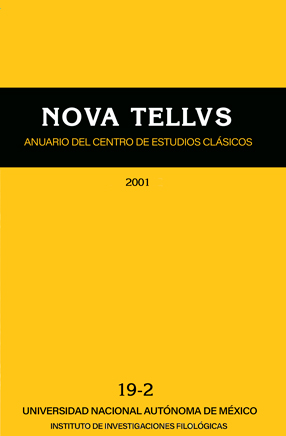Marcial: tiempo y celebración en los epigramas
Main Article Content
Abstract
This article deals with the relationships between the epigram and the concept of time and celebration. In it three main aspects are analyzed: first, that the epigram, as a particular sort of poetry, tends to perpetuate the present moment in the memory. Second, that Martial's epigrams are very close to the Satumalia. Finally, that the epigram is the very moment when the historie time matches to the cosmic time—furthermore, the epigram, as all fine arts, creates its own time.
Downloads
Metrics
PDF views
20
Article Details
How to Cite
Lejavitzer L., A. . “Marcial: Tiempo Y celebración En Los Epigramas”. Nova Tellus, vol. 19, no. 2, June 2023, pp. 173-86, https://revistas-filologicas.unam.mx/nouatellus/index.php/nt/article/view/1054.
Section
Artículos

This work is licensed under a Creative Commons Attribution-NonCommercial 4.0 International License.
Copyright Notice
The authors who publish in NOVA TELLVS accept the following terms:
- The author or authors commit themselves to sign a Declaration of unpublished text and proprietary rights assignment authorizing the publication in the different platforms and spaces of diffusion of NOVA TELLVS and ceding the proprietary rights on the work in total and exclusive form to the Universidad Nacional Autónoma de México, according to article 84 of the Federal Law of Copyright and others relative and applicable to its regulation, in the understanding that the right of the author over the work will be respected, and the corresponding credit will be granted to them.
- All texts published by NOVA TELLVS—without exception—are distributed under the Creative Commons 4.0 Attribution - Non-Commercial (CC BY-NC 4.0 International), which allows third parties to use what has been published as long as they mention the authorship of the work and specify that the first publication was made in this journal.
- Authors may enter into other independent and additional contractual arrangements for the non-exclusive distribution of the version of the article published in NOVA TELLVS (e.g. including it in an institutional repository or making it known in other paper or electronic media) provided that it clearly and explicitly states that the work was first published in this journal.
- For all of the above, together with their proposed material, authors must submit the Declaration of unpublished text and proprietary rights assignment format of the first publication duly requisitioned and signed by the authors. This format should be sent as a PDF file to novatellus@unam.mx or iiflnovatellus@gmail.com

